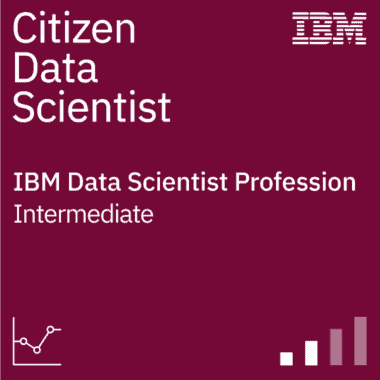Case Study: The Future Starts with Citizen Data Scientists

How IBM is developing the next generation of transformation-drivers by turning supply chain SMEs into Citizen Data Scientists

Company Fact File
Name: IBM Corporation
Sector: Information Technology and Services
HQ location: Armonk, NY
Revenues: $10 billion plus
Employees: 5,000 plus Employees
Web url: www.ibm.com

When COVID-19 hit, IBM Supply Chain found that its digital transformation journey had enabled the resiliency needed to tackle major disruptions. That awareness led to the decision to further accelerate their digital transformation projects. To keep up with the demand of exploiting emerging technology while preparing for future, IBM launched a first-of-a-kind transformational upskilling initiative designed to democratize data while empowering individual business technologist (SMEs). This transformative initiative is a prime example of the mantra Ron Castro, IBM Vice President and Chief Supply Chain Officer, constantly challenges his organization with “innovate anywhere, use everywhere.”
The initiative, dubbed the Citizen Data Scientist (CDS) Certification program, was designed to help supply chain SMEs develop the data science skills they need to make data-driven decisions in a fluid business environment — and then roll it out to the rest of the company to engage employees in successful process improvement throughout every part of the organization.
In just the first year, the CDS program developed by IBM Supply Chain, in partnership with the IBM Data Scientist Profession Team, the company already was seeing results. The first supply chain SME cohorts to go through the program’s data science, data wrangling, and data visualization upskilling and reskilling structured learning program resulted in more than $1.6M in efficiency and productivity improvements and inventory savings from improved decision-making.
All this in just six months, and with zero financial investment. And the program has only continued to grow ever since in both the breadth of its content and its reach across the company.
What Is a Citizen Data Scientist?
As manufacturing moves into M4.0, the role of big data is only getting bigger — and more ubiquitous throughout operations. Data scientists, who usually have a master’s or PhD, are essential. However, there may not be enough of them to go around, and even if there are, their level of business expertise may not be sufficient in a specific domain.

Hence the rise of the Citizen Data Scientist. According to Gartner, a citizen data scientist is “a person who creates or generates models that leverage predictive or prescriptive analytics, but whose primary job function is outside of the field of statistics and analytics. They bridge the gap between those doing self-service analytics as business users and those doing advanced analytics as data scientists.”
IBM’s Citizen Data Scientist digital credential is designed to create more of these data-savvy employees so they can bring the power of data analytics to aspects of their daily jobs without having to rely on those who call data science their profession. At IBM, the CDS certification also is integrated into the company’s career path, so it serves as a starting point for those who might be interested in becoming a full-fledged data scientist.
Starting with an Innovation Foundation
The CDS certification program was established on a foundation of innovation that would encourage continuous transformation. One bedrock of this foundation was to reimagine and transform people’s analytical skills using IBM and open-source technology to retain and create a high-performing, engaged culture. Another was to leverage the reskilled SMEs to reimagine processes, then apply AI and Cloud technologies to implement new processes to accelerate transformation.

“The CDS certification program was established on a foundation of innovation that would encourage continuous transformation.”
“We wanted to certify people who could really work on data to bring our broader population into IBM’s digital transformation,” says Matthias Graefe, IBM’s Director of Supply Chain Transformation. But it isn’t enough to just offer one-off classes in, for example, Python programming, which would likely result in the creation of isolated applications and solutions. The company also wanted to ensure that its latest crop of Citizen Data Scientists has an understanding of cybersecurity, because a talent in programming doesn’t automatically mean the person understands how to ensure the programming, they’re creating is also compliant, Graefe says. “We knew we wanted to achieve both sides of it — enabling people in a supportive way, while also creating a community and governance around what they are doing.”
Taking the CDS Challenge
Brenda Berg, CDS Program Manager, advises that the CDS program requires more than just watching some videos and taking a test to earn the digital credentials. It may not be as difficult as becoming a full-fledged data scientist, but the Citizens Data Scientist certification still is no walk in the park. In fact, only 70% of the first year’s CDS trainees made it through the program. The nature of the learning, uninterrupted time commitment and demanding day jobs are what makes the program challenging.
To help keep candidates on the learning path, the program is highly structured and includes having a technical leader, a program manager, and a project manager agree to facilitate the process. Each candidate also is assigned a mentor to help them develop the data scientist mindset and build the new ecosystem together with professional data scientists. Employees who chose to participate could leverage their allocated IBM global training program learning hours to gain data science knowledge and skills.
CDS candidates initially were chosen by their managers because it takes a true commitment on both the participant and their managers, says Giovanna Benetti, Digital Supply Chain Transformation Leader. The self-paced training is done in parallel with participants’ day-to-day jobs, so both their managers and the participants need to ensure that they can complete the program while still getting their daily work done.
The data science mentor role also is a key one, she adds. They meet regularly with CDS participants to assist with coursework understanding, application, and provide guidance on the required Citizen Data Scientist project plan to complete the certification. Now that the program has an established, and growing, bank of certified Citizen Data Scientists, the idea is that some of those who have been through the program can now turn around and assist new trainees within the CDS community. Or, as Anita Toth, Global Supply Chain Manufacturing Operations and Integration Manager, says, “We now have started to eat our own cooking. The people who have graduated from the CDS program are now applying their skills back to the business, either vertically in their own domain or cross-organizationally. We have some Citizen Data Scientists who just graduated one year ago who now are guiding people who are currently in the program.”

“A key component to the program is that participants also must apply what they are learning to real-world projects.”
Another key component to the program is that participants also must apply what they are learning to real-world projects. These projects generally fall into three buckets. One is what IBM calls “big rocks,” which are multidomain, large-scale projects that are important to the organization overall. “It’s a benefit for employees to work on these big rocks projects, because they can both experience different functional areas, and are able to contribute on projects that have a big impact,” says Graefe. Then there are smaller projects, or “pebbles,” which generally fall within a specific business or functional area, and even smaller, more specific “sand” projects. Of course, the big rocks projects result in the most material savings — and the highest visibility. As an example, a 2020 CDS participant’s pebble project resulted in a $50K inventory savings for his business unit. After CDS graduation, he partnered with CDS multidomain colleagues to drive a services and manufacturing synergy project. Over the past two years this advanced deep learning-machine learning model contributed over $10 million in inventory savings and cost reductions.
The key to successfully completing the program is for the candidate to have the support of their manager or supervisor, and their entire team. Erin Thalacker, CDS Project Manager, also advises it’s vital to connect early and often with their data science mentors so everyone understands what business problem they’re trying to solve through data science, and also make sure they have access to data and that they understand that data, as well as for help navigating any roadblocks they may hit along the way.
The program still is tough, but those who make it through feel more prepared to be the technologists IBM will need for a future in which automation and data analysis will continue to be increasingly key for most job roles. Having a mentor also is a big boost for many who go through the program, as is having a community of fellow Citizen Data Scientists who not only understand what they are doing, but also can share solutions to common challenges across functionalities. Another perk? Added visibility. “We have a strong sense of community across Supply Chain, and to be able to make an impact in that community is a strong driver within the program,” says Graefe.
Scaling Up
As important as it was to quickly reinvent the supply chain, the program also was designed to be scalable throughout the company by basing the CDS on data science methodology, tools and data trainings that were domain-agnostic. This means that the program can be replicated for any other part of the organization that wants to jump-start its transformation journey with reskilled, resilient, Citizen Data Scientist SMEs.
This is already starting to happen. The original Citizen Data Scientist certification program has been leveraged to pilot additional Citizen Process Designer, Citizen Automator, Citizen Front End and Backend Developer programs.
There was a strong use case already built-in for expanding the program, says Graefe. For example, as IBM continues its drive toward automation, there is a need to create more bots. But those bots need to be programmed so that they add to the greater good — otherwise, they could just create chaos. Also, he says, there was a need to use a common platform and tool set so people can share successful components as they scale up the automation. “If we want to eliminate, simplify and automate, and to drive automation everywhere into our workflows, we need to expand the Citizens program,” he adds.

“The program was designed to be scalable throughout the company by basing the CDS on data science methodology, tools and data trainings that were domain-agnostic.”
“If you need to develop an application, you need people who understand the business requirement, can write the code, and you also need people who can design the UI for the application on the front end. Then you have the automators on the back end. Also, now it’s not just about developing code; it’s about working on platforms, often with low-code applications — you often don’t need deep coding skills now. We wanted to bring all of them under one Citizens umbrella.”
Next up is a pilot program with another business unit that works closely with Supply Chain to see if they can “lift and shift” to make the CDS program work for their specific needs. The team also is close to implementing an overall system to manage the projects the prospective Citizen Data Scientists will be working on so innovations can be shared on platforms with communities who could link those innovations to other areas.
“Our next step is to scale up the CDS to Innovation Technology and get through the pilot, then open it up to the broader IBM community,” says Graefe. “We are creating a community of those who finish their projects and graduate, who then are offered the opportunity to become Citizen Technologists and work across transformation projects to co-create across the supply chain and, hopefully, across IBM in the future.” M
About the author:
Sue Pelletier, a contributing editor with the Manufacturing Leadership Journal, is a seasoned writer/editor with experience in online, social media, e-newsletter, tablet app, book and e-book, and print publications.